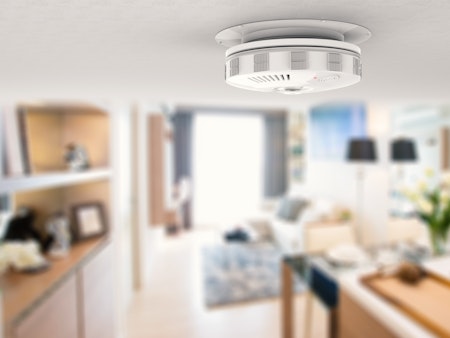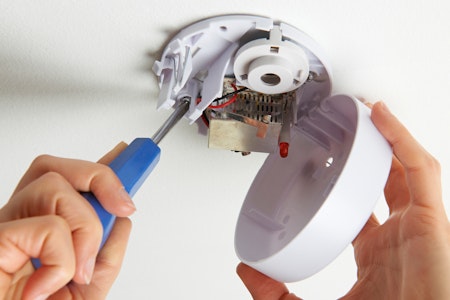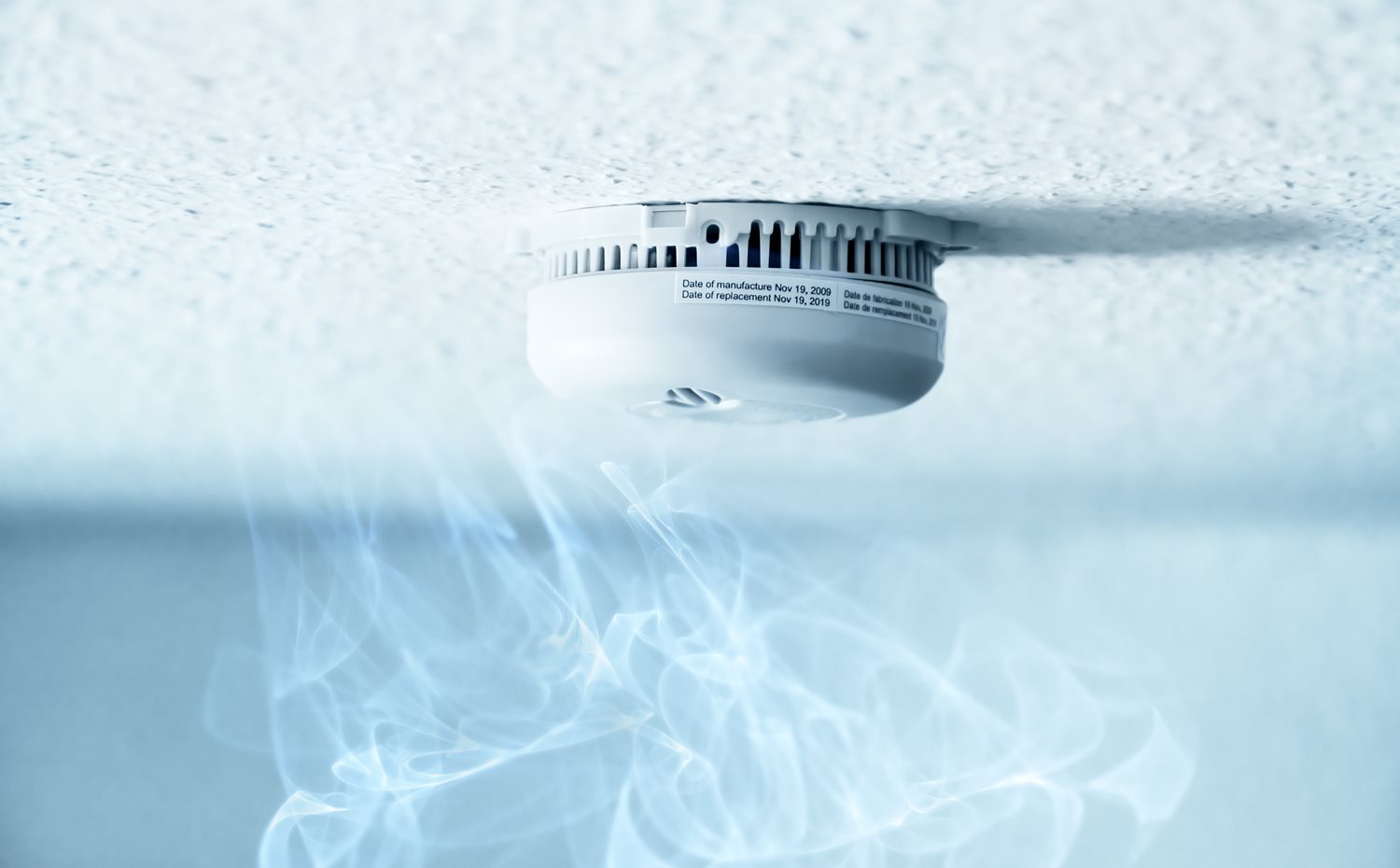It can be hard to tell if a fire alarm is faulty unless it’s regularly tested. So, it’s important to make sure that suitably competent people oversee its installation, maintenance, repair, or replacement should it fail.
In this guide, NICEIC’s electrical experts take you through the different types of fire alarms available, what the regulations say about fire alarm installation and safety, as well as delving into the processes of installing, maintaining and replacing fire alarm systems, helping you protect your home or business premises in the long term.

Different types of fire alarm systems
To help you understand what type of fire alarm system might be best for your home or business, we’ve listed some of the most common types below. The type of system you choose will depend on your unique circumstances and requirements, which is why it’s always a good idea to take advice from a professional who is experienced in the installation of fire detection and alarm systems.
Smoke and heat detectors
The most common alarm systems in domestic properties use a combination of smoke and heat detectors.
Smoke alarms are typically used for hallways and landings, while heat detectors may be used in kitchens. Both detection devices are designed to provide an early warning system, ensuring people can evacuate the property before the fire spreads.
When these devices detect smoke in the air or rising heat, they will set off the alarm.
Conventional fire alarm systems
These systems are among the most commonly used in larger residential and smaller business settings. They divide a building into zones, each of which might have multiple detectors. When a detector is triggered, the control panel will indicate which zone is in alarm, but not exactly where the fire is.
You’ll often find conventional systems in small commercial buildings like shops or restaurants, or houses in multiple occupation (HMOs).
Addressable fire alarm systems
Unlike a conventional system, addressable systems allow you to give each fire detection device a specific ‘address’, so you can easily pinpoint the exact location of a fire (for example, Board Room 2 on the fourth floor). This can help fire rescue teams to access the fire more quickly and minimise property damage.
Addressable systems are frequently used in large commercial premises or industrial settings.
Wireless fire alarm systems
Like the name suggests, with wireless fire alarm systems there is no cabling connecting the detection devices to the main control panel (or between detectors and sounders in domestic properties).
These systems can be useful in buildings where wiring would be considered unsightly, or for historic or listed buildings with restrictions on wiring.
Smart fire alarm systems
The rise of the Internet of Things (IoT) means that a plethora of smart devices are pouring onto the market, including smart fire alarm systems.
These systems can usually be controlled and monitored from a mobile phone app, giving you vital information on their state of repair and battery life.
Fire alarm categories and gradings
Fire alarm systems are described in BS 5839 parts 1 and 6, the codes of practice for fire detection and fire alarm systems in buildings.
Fire alarms can be split into three broad categories, these being:
- Category M systems: these are manual systems that must be operated by a person, typically by breaking the glass in a manual call point – commonly referred to as a ‘break-glass unit’ – installed on the wall.
- Category P systems: prioritising the protection of property, these systems are designed to ensure the fire is extinguished quickly, safeguarding the building from damage. They’re often used in spaces such as warehouses, museums, data centres, and unoccupied premises where damage could prove extremely costly or irreplaceable assets might be lost.
- Category L systems – these are divided into ‘L’ systems (for commercial property) and ‘LD’ systems (for domestic property), which are both designed to save lives. They use fire detection devices to ensure the occupants of a building are pre-warned of a fire and have time to evacuate.
In domestic premises, to ensure they are fit for purpose, fire alarm systems are graded according to the level of protection they offer; A (highest), C, D and F (lowest).
These categories and grades can be further broken down according to their purpose and the level of protection they provide.
Regulations on fire alarms in buildings
You might be wondering whether fire alarms are required by law, or whether the decision lies with individual homeowners or business owners.
Domestic properties
In domestic new builds in England and Wales, the Building Regulations Document B now requires fire alarm systems to be at least category LD3 and at least grade D2. Heat alarms are also required in kitchens where the kitchen isn’t separated from the hallway or landing by a door. In hallways and landings, optical smoke alarms are recommended.
Northern Ireland’s Building Regulations – Technical Booklet E requires fire alarm systems in new builds to be at least category LD2 and at least grade D2, including a smoke alarm or alarms in every habitable room and a heat alarm in every kitchen.
Please note that in England, Wales, and Northern Ireland, there are no rules requiring homeowners to install fire alarm systems in existing buildings.
In Scotland, however, homeowners have been legally responsible for installing interlinked fire alarm systems and carbon monoxide detectors (where applicable) in their properties since 2022. A linked system means that when one alarm in the system goes off, they all sound, alerting people in all areas of the building.
Depending on where you live in the UK, it’s important to note that older buildings might not have fire alarm systems that meet current standards, and they might not even have one at all. According to statistics from the International Fire and Safety Journal, over 12,000 house fires occur per year in homes without fire alarms.
Rented sector
In 2022, the rules regulating the installation of fire alarms in rented homes – The Smoke and Carbon Monoxide Alarm (England) Regulations – were updated. These, rules, which apply to both the private and social rented sectors, state:
Both private and social rented homes must have at least one working smoke alarm for each storey where there is a room used for living accommodation.
There must be a carbon monoxide alarm in any room used as living accommodation that contains a fuel-burning device (with the exception of gas cookers).
Landlords are responsible for checking all alarms are in good working order at the beginning of a tenancy.
Landlords are also responsible for repairing or replacing faulty or broken smoke or carbon monoxide alarms during the tenancy, once the tenant has let them know there’s a problem.
Similar laws apply in the devolved nations, including:
- Fitness for Human Habitation (FFHH) Regulations (Wales).
- Scottish Government Guidance for the Provision of smoke and heat alarms when installing, maintaining or repairing them
- The Smoke, Heat and Carbon Monoxide Alarms for Private Tenancies Regulations (Northern Ireland) 2024.
Commercial properties
For businesses, the regulations are less specific; however, in line with the Regulatory Reform (Fire Safety) Order 2005, all businesses must have an appropriate fire alarm system installed on their premises.
It’s up to the designated ‘responsible person’ – this could be an employer, the building owner, or a facilities manager – to decide what category and grade of fire alarm is most appropriate for their building. This decision should be based on a thorough fire risk assessment, which is crucial to determining the most appropriate fire alarm system for your commercial building.

Choosing the right professional to install your fire alarm
When it comes to fire safety, it’s best not to leave anything to chance.
That’s why you should always employ a suitably competent registered electrician or fire alarm technician for any job involving the installation, replacement, or repair of all but the most basic domestic fire alarm systems.
Installing a fire alarm system involves understanding the proper placement of system devices, compliance with safety regulations, and the performance of the proper testing procedures.
The more complex your installation is, the more likely it is that a DIY job will result in an incorrectly or dangerously installed device, leading to costly repairs or even an alarm that fails to operate when you need it the most.
Vetting your chosen professional
When considering who to choose for the job, you might want to consider:
- Registration with relevant bodies and schemes: such as the BAFE Fire Safety Register and/or NICEIC.
- Reviews and recommendations: whilst online reviews won’t tell you about an installer’s competence or qualifications, good reviews can be a positive indication of high-quality work and trustworthiness.
- Get a few different quotes: getting multiple quotes for your job will help you find the right installer for you at a price you’re happy with.
There are lots of websites out there that will help you compare and contrast different service providers and choose the right company for you. For example, you can use NICEIC’s Find a Trusted Tradesperson tool to find registered electricians in your area with the right qualifications and certifications for your fire alarm installation, replacement, or repair.
Fire alarm maintenance
It’s important to keep your fire alarm in good repair so that it’s ready to protect you in the event of a fire.
Commercial buildings
According to the Regulatory Reform (Fire Safety) Order 2005, fire alarm systems in commercial buildings must be ‘adequately maintained’, meaning it should be in good working order at all times.
In addition to this, BS 5839-1 makes specific recommendations for the maintenance of fire alarm systems in non-domestic premises, including:
- weekly testing by the building’s responsible person
- professional fire alarm maintenance every six months by a competent person.
Rented sector
As mentioned earlier in this guide, landlords are responsible for maintaining and repairing fire alarm systems in private and social rented properties.
Equipment such as smoke and carbon monoxide detectors should also be accessible for routine checks by tenants, and you should stress the importance of such regular testing in any instructions provided.
Domestic properties
There aren’t any specific rules regulating fire alarm maintenance in domestic properties.
However, it’s generally recommended that you test your smoke alarms every month or so by pressing the test button, that you change the batteries regularly, and that you replace smoke alarms once they reach the end of their lifespan (typically around 10 years).
For homeowners, installing a fire alarm system helps keep you and your family safe. It provides an early warning sign for fire hazards and helps you get out of the property quickly and safely.
For businesses, failing to install an adequate fire alarm system will put you at risk of violating fire safety regulations – potentially leading to fines or legal action should a fire break out. Individuals who are responsible for fire risk assessments are legally obliged to ensure appropriate fire safety measures are in place, including the installation and maintenance of fire detection and alarm systems.
You may also face complications with insurance companies if a fire breaks out and you have no alarm system in place. Many insurance companies require fire safety measures, including alarms, to be installed before they will pay out on a claim.
Ultimately, without a warning system, the chances of a fire spreading and causing damage to life and property are much higher. This can lead to greater and more costly damage to your home and workplace – as well as risking lives.
Whilst DIY installation is possible for simpler domestic fire alarm systems, a professional installation is preferred for anything but the most basic systems to ensure compliance with all the relevant regulations, and to keep you and your building safe.
This is particularly true when it comes to more complex systems that need to be wired into the mains, or large commercial setups, which nobody but competent fire alarm technicians should be touching.
You can find a reputable registered electrician or fire alarm installer by visiting NICEIC’s Find a Trusted Tradesperson tool.
The cost of installing a fire alarm or fire alarm system can vary based on the type of alarm, labour costs and how many individual devices need to be installed on the system.
At NICEIC, finding a trusted and registered fire alarm technician has never been easier.
Simply visit our Find a Trusted Tradesperson tool, fill in your job details, and send your job request off to local NICEIC-registered fire alarm technicians for a quote.
Don’t risk doing it yourself. Experience peace of mind, knowing you’re choosing from qualified experts who are ready to get the job done right.
If you have a larger home or business premises, you might consider a more complex fire alarm system. This might be an addressable system, which allows you to pinpoint the location of a fire, or a category P system, which is designed to minimise property damage.
For all but the most basic home fire alarm systems, it’s advisable to hire a competent fire alarm technician (who may also be an electrician), preferably one registered on NICEIC’s BAFE Fire Detection and Fire Alarm Systems Scheme.
These technicians are regularly assessed against the latest fire safety and fire alarm systems regulations, ensuring their work is up to scratch, compliant, and fit for purpose.
All information shared is correct as of September 2025.
